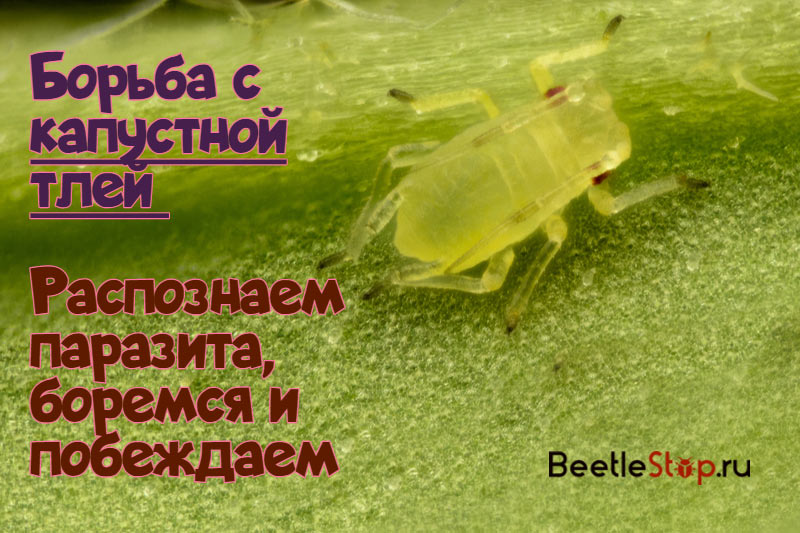Who is cabbage aphid and by what methods can I get rid of it?
Cabbage aphids are a known pest of cruciferous crops. She begins to attack the plants before the head of the ovaries, and if you do not catch on time, then you can lose the entire crop. Adults and young insects suck out the juice from young shoots and thus do not give them the opportunity to fully develop - the culture begins to wither away and soon dies. But, in addition to this, this parasite can cause the spread of one of the 20 viral diseases of plants. Given all the facts, it becomes clear that it is very important to detect the pest in a timely manner and take steps to destroy it.

How to recognize a parasite?
Before you learn how to deal with aphids on cabbage, it is advisable to find out everything about her lifestyle. This insect has a small size - the body length does not exceed 2.2 mm. And thanks to the green color, the parasite is able to become completely invisible. The aphid sitting on a leaf gives out only a light gray shade of wax coating, which covers her entire body.
The main source of food is the plant sap, to which the pest gets using a special sucking organ that looks like a proboscis. It is so sharp and strong that it allows the insect to pierce the surface of a leaf plate or stem of a young shoot without much effort and become saturated with nutrient fluid.
On a note! The cabbage length has quite a few natural enemies, and one who has the imprudence to attack her either dies or immediately refuses to eat his victim. And this is due to the fact that in the body of this parasite there are two special substances - glucosinolates and myrosinases. The first comes with the juice of plants, the second is an enzyme. At the time of danger, these substances find themselves in the stomach, where they mix and form mustard oil, and for most insects this is a real poison!
The main danger from cabbage aphids lies in its life cycle. In just three summer months, the parasite manages to change from 10 to 20 generations. Throughout spring and summer, females are born, and the process of their birth occurs without the act of fertilization. One female becomes the ancestor of 40 larvae. Around July, insects with wings are born, which can easily fly to neighboring crops and thus quickly spread to the beds. Closer to fall, males are born. They fertilize the females, and they, in turn, lay their eggs on the bare stumps. Eggs hibernate, and in spring new individuals emerge from them.
Methods of struggle
The continuous cycle of the emergence of new insects throughout the warm season makes the fight against cabbage aphids an occupation very troublesome. It multiplies rapidly and spreads almost instantly throughout the garden. But at the same time, knowledge of these features makes it possible to select effective measures and guaranteed to get rid of the pest in cabbage plantings.
Folk methods
Ways to combat without the use of chemicals is chosen by most gardeners. They will require a certain amount of preparation time, but at the same time they will preserve the ecological purity of the culture. You can do the following:
- Pour cruciferos abundantly with very cold water. Using this method, it will not be possible to destroy all insects, but you can still significantly reduce their number.
- Plantings are sprayed with infusion of ash, celandine, yarrow, horse sorrel, hot pepper or tobacco. The tool is prepared on the basis of 300 g of the selected base, which is poured with a bucket of hot water. After a day, you can carry out the processing of plants.
Recommendation! For this operation, it is advisable to choose a sunny day, as in rainy weather your efforts will be in vain!
- Potato tops in the amount of 2 kg must be poured with a bucket of water, insisted during the day and sprayed with the obtained product cabbage seedlings.
- Good results are shown by the infusion of tomato greens - you should take about 5 liters of water per liter jar of tops, insist and process the garden.
- Pour a couple of glasses of onion husks with two liters of boiling water. Leave for an hour, then dilute in a bucket of water and use for spraying.
But to get the best result, all of the above drugs should be enriched with a soapy solution. It can be prepared on the basis of any liquid or ordinary laundry soap. The finished product is applied to the lower surface of the leaves using a spray or soft sponge. In this case, processing must be carried out in the evening.
Folk recipes work well in conjunction with additional activities. For example, next to cabbage, you can plant dill or testicles of carrots. These plants are attractive to the few natural enemies of cabbage aphids that can destroy it. These include the larvae of the fly-fly, ladybug and lacewing.
Chemicals
Chemicals are used mainly in vast fields where cruciferous plants are grown on an industrial scale and provided that the degree of damage exceeds the economic threshold of harmfulness - more than 5%. In this case, such insecticides are used as:
- Karbofos;
- Inta-Vir;
- "Bee 58";
- "Karate";
- "Decis";
- "Spark";
- Rovikurt, etc.
These drugs are sprayed using special spray guns, after diluting them to a certain concentration according to the instructions. A prerequisite for this is the use of personal protective equipment.

